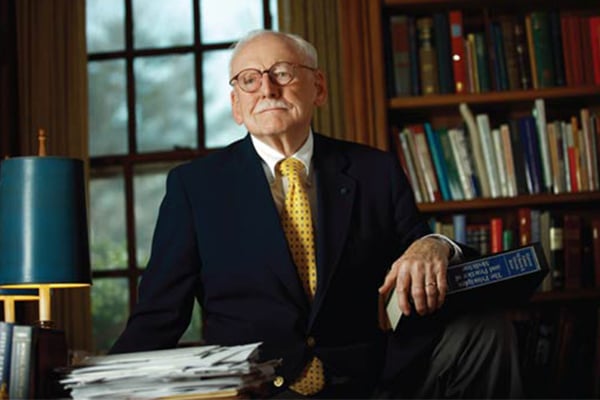Richard Johns, founding director of the Johns Hopkins Department of Biomedical Engineering, died Nov. 29 at the age of 95 from complications of dementia. Johns oversaw the department’s development into an internationally recognized leader in biomedical engineering, with a record of impact across many disciplines.
Much of Johns’ professional education and career took place at the Johns Hopkins University School of Medicine. Those who knew him well recall his commitment as a physician, teacher, and researcher. His contributions to medicine, science, and education were exceptional, as was his instinct for collaboration, which figured significantly in the leadership role he played to define the field of biomedical engineering.
Johns was named the first professor of biomedical engineering at Johns Hopkins in 1966 and then appointed head of a new division of biomedical engineering in the Department of Medicine. The division became a full department at the School of Medicine in 1970, with Johns as its first director. When the Whiting School of Engineering was founded in 1979, Johns championed a new undergraduate program in biomedical engineering—a program that has long been ranked #1 in the nation by U.S. News & World Report and is the university’s largest major. In 1991, he was succeeded as biomedical engineering director by the late Murray Sachs.
In a whitepaper to the National Institutes of Health in the 1970s, Johns coined the term “systems biology” as the study of the integrative function of biological systems using engineering approaches. He built the BME department on this guiding principle, recruiting engineers who specialized in basic science research, each renowned in their respective disciplines for applying new technological approaches to answer biological questions. Under his leadership, the Department of Biomedical Engineering bridged the gap between science and technology, providing an array of services such as clinical engineering and computing that translated knowledge into applications and solutions.
With Johns at the helm, the department expanded research programs in hearing, cardiovascular control, systems physiology, and myocardial mechanics. He also established close research collaborations with the Johns Hopkins University Applied Physics Laboratory, including development of use of the argon laser for retinal surgery.
In his own research, he determined the biological origins of myasthenia gravis and other chronic neuromuscular disorders, and he was instrumental in developing a revolutionary, three-dimensional radiography system that gave physicians the ability to observe structures behind dense organs, among other breakthroughs.
Johns was a dedicated leader with an even-handed management style and a commitment to mentoring, and he established within the department a deep sense of collegiality. Richard S. Ross, former dean of the Johns Hopkins School of Medicine, once said, “Dick Johns’ modesty about his outstanding achievements may be exceeded only by his sparkling sense of humor. His most outstanding quality, however, is his willingness at all times to help a colleague or friend, no matter at what sacrifice to his own activities.”
Born in Pendleton, Oregon, in 1925, Johns was interested since childhood in science and medicine, tinkering with everything from motors to phonographs to the early homemade radio receivers known as “crystal sets” that were popular in the 1920s and 1930s.
He came to Johns Hopkins in 1944 as a medical student after pursuing an undergraduate degree in physics at the University of Oregon.
While he was a medical student, Johns became a laboratory technician for Samuel Talbot, a founder of the biomedical engineering field and head of a biophysical division in the Department of Medicine. Johns quickly became proficient in building oscilloscopes, which were used to measure patients’ heartbeats and brain waves, and other devices.
After leaving the School of Medicine to conduct research to fulfill his two years of required Army service, he completed an internship, residency, and postdoctoral fellowship at Johns Hopkins before being appointed to the Department of Medicine faculty.
Johns is survived by his three sons — Dr. James Johns, Richard Johns, and Robert Johns — his seven grandchildren, one great-granddaughter, and other family members. His wife, the late Dr. Carol Johnson Johns, was a renowned lung disease expert who served as an assistant dean at the Johns Hopkins University School of Medicine and an interim president of her alma mater, Wellesley College. Richard and Carol met when they were both medical residents.

